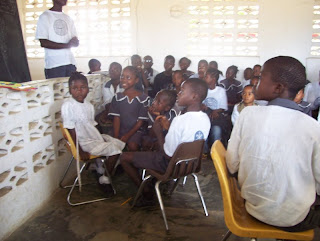What is Liberia Orphan Education Project (LOEP)?
LOEP is a small group of people who are committed to supporting education for orphans and vulnerable children in Liberia. It began with a very modest effort to send periodic shipments of school supplies to orphans in the closing years of the war.
How did we get involved in this?
Several of us heard Rev. Sam-Peal speak about the devastation of Liberia's war when he was in Virginia. We were inspired to action and formed a non-profit organization (LOEP) to do what we could to provide ongoing educational support for Liberian orphans of war.
What does LOEP do now to support education for orphans?
Through Rev. Sam-Peal, LOEP was introduced to two struggling orphanages that operate schools for their children. LOEP has worked with the two orphan schools, Children Relief Ministry (CRM) and Alfred and Agnes Memorial Orphan Mission (AAMOM) and partnered with them for several years.
1) LOEP underwrites the teacher payroll at CRM through our Sponsor a Teacher Program. A donation of $50 to LOEP sponsors a teacher's salary for one month!
2) LOEP sends periodic shipments of school supplies, instructional materials and books as well as other needed items to AAMOM.
How does LOEP know that the orphanages in far-off Africa are accountable and responsible?
LOEP board members do extensive research before committing funds or support to any institution or project. LOEP partner orphanages and projects are carefully vetted to determine that they remain a) certified by the Liberian Ministry of Health, b) have been reviewed be the United Nations Mission in Liberia (the largest UN peacekepping operation in the world), c) are qualified to receive food supplements from legitimate organizations with offices in Liberia such as Christian Aid Ministries, World Food Program (UN) and others.
LOEP Board Member Brenda Weeks travels annually to Liberia. Her yearly visits to LOEP partner orphanages and meetings with appropriate organizations and officials on behalf of LOEP help to insure personal contact and strengthen the partner relationship. LOEP has developed a reliable network of supporters and friends in Liberia and in the US who assist in maintaining accountability and transparency.
How is LOEP funded?
LOEP has a small, committed group of individual donors who faithfully support the effort to educate orphans through LOEP projects. All of LOEP's work is supported by this group of individuals who are Friends of LOEP. LOEP has no overhead and no operational costs. All work is on a volunteer basis and all travel expenses and any other expenses not directly used for CRM teacher salaries or school supply shipments are borne by volunteer individuals.
Does LOEP work with other organizations?
Yes.
Seveal Rotary Clubs have partnered with LOEP to provide support for specific projects for orphans in Liberia such as classroom construction and improved water supply.
LOEP has often worked alongside the mission effort of Browntown Church in Virginia. Some active members of Browntown Church are also Friends of LOEP.
The recent LOEP Teacher Training in Liberia was a joint project with Lott Carey Mission School. Teachers from CRM and AAMOM orphan schools participated in the training offered at Lott Carey School. There were 10 teachers from orphan schools involved in the teacher training at Lott Carey School (along with 40 teachers from Lott Carey and other community schools). Four of the orphan school teachers were identified as trainers and will help train their peers at the orphan schools.
 The LOEP board of directors from left: Elizabeth Iden, Phylis Benner, Brenda Bush-Weeks at Children Relief Ministry orphan school.
The LOEP board of directors from left: Elizabeth Iden, Phylis Benner, Brenda Bush-Weeks at Children Relief Ministry orphan school.















































